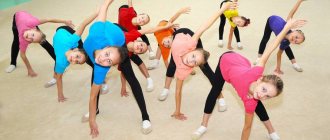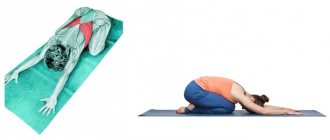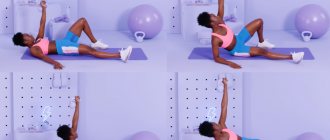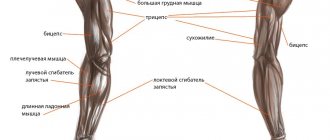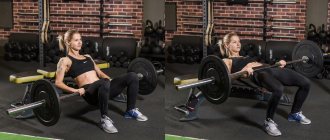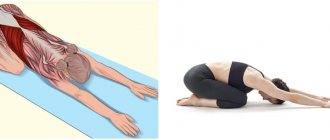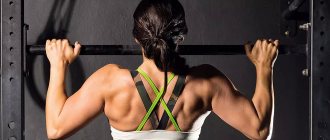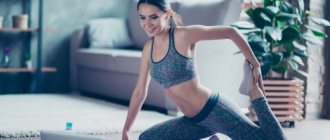What are the dangers of sedentary work?
First of all, sedentary work disrupts the blood supply to tissues and blood vessels due to a posture that impairs blood flow and disrupts the functions of organs and systems. Such a sedentary lifestyle leads to diseases, dysfunctions of the pelvic organs, and worsens sexual function.
Secondary reasons, but no less harmful, are poor posture and muscle atony. Some muscles are in hypertonicity, for example, the trapezius, which worsens not only posture, but also the blood supply to the vessels of the head, since the vessels in the neck are pinched by an overstrained muscle. Therefore, it is important to promptly relieve tension from overloaded muscles and tone relaxed ones.
Exercise 1 For the front of the thigh
Sit on the edge of a chair and place your feet together, pressing your knees together. The back must be straight. Alternately straighten your left and right knees, pulling your toes towards you. Perform the exercise until a slight burning sensation occurs in the muscles.
If this exercise is too easy for you, straighten both legs at once, remembering to keep your knees together. This option also allows you to use your abdominal and back muscles.
More on the topic: Fitness in the office>>
A set of exercises for fitness in the office
Warm-up
Head tilts
An office worker's neck muscles suffer no less than their back, so to relax and warm them up, it is necessary to perform a number of exercises.
Standing straight, tilt your head towards your shoulder, but without raising your shoulder towards you. It is important not to bend as low as possible, but to gently stretch the neck muscles from the side. Then you need to change the inclination and alternate 10-15 times on each side.
Head turns
When turning, it is important to keep your chin in line. Also, do not force your head back. Perform turns without jerking, concentrate on the neck muscles. Perform 10-15 turns in each direction.
Circular movements
In this exercise, it is necessary to perform a semicircle without throwing your head back, as this can cause discomfort and pain. It is enough to perform a semicircle from shoulder to shoulder, stretching the back of the neck. A total of 10-15 turns in each direction.
Shoulder rotations
Perform circular movements with your shoulders back 15-20 times at maximum amplitude. Then repeat forward movements.
Hand rotations
Also perform circular movements with your arms at full amplitude, effectively stretching the muscles and working the joints. In one direction and the other - 10-15 repetitions.
Torso rotations
It is important to perform rotations exclusively in the thoracic spine. To do this, you need to tighten your abdominal muscles and fix your lower back. Place your feet hip-width apart, spread your arms to the sides at shoulder level. As you exhale, rotate to one side without moving your pelvis; while inhaling, return to the center. And once again, as you exhale, twist your torso in the other direction. And so 10-15 repetitions for each.
Torso bends
Raise one arm above your head and repeat 15 to 20 bends in one direction, then in the other. The bends should be quite energetic, but not sharp. When performing it, it is important not to move your pelvis to the side; bend only through your torso, and not your whole body.
Circular movements of the pelvis
The exercise warms up the hip joint and ligaments. Perform rotations in a full circle, that is, with a maximum amplitude, 10-15 times in each direction.
Half squats
Half-amplitude squats will help warm up the knee joints, minimally involving unheated leg muscles in the work. Squat without bringing your thighs parallel to the floor. Raise your arms in front of you as you bend your knees. Place your body weight on your heels. Perform 15-20 repetitions.
Knee extension
While standing, raise your thigh parallel to the floor and extend your knee 10-15 times, maintaining balance. Repeat on the other leg. This exercise will warm up your knee joints and quadriceps.
Calf raises
Shift your body weight from your toes to your heels. The exercise will help not only warm up the ankle joints, but also the muscles of the lower leg. 10-15 times.
Circular movements of the foot
Rotate each foot in one direction and the other 10-15 times.
Set of exercises
Squats
Perform squats until they are parallel to the floor, if office clothes allow. The main goal is to work the gluteal muscles and hips, which are the foundation for a healthy spine. Perform the approach until you feel a burning sensation in the muscles. With bodyweight, 30-50 repetitions may be sufficient.
Forward bends
This exercise will stretch and relax tight muscles in the back of the body, while strengthening the lower back and buttocks. Place your hands on your waist and bend over with straight knees without rounding your back. The main goal is to stretch the back of the thighs, and not bend as low as possible. Perform 20-40 inclines.
Swing your legs to the sides
During the exercise, you can use the back of a chair for support or maintain balance yourself. Move your leg to the side not with a sharp swing, but with the strength of your thigh and buttock muscles. As you exhale, lift your legs a little faster and lower them down slowly. Perform 15-20 swings on each leg. The more concentrated the swings are, the more difficult they are to perform.
Swing back
This option strengthens the gluteal muscles. The main thing is not to bend your lower back when abducting your leg. Grasp the back of a chair or the edge of a table with your hands. Bend your torso forward and lift the foot of your working leg off the floor. As you exhale, move your leg back using your buttocks. Do not make sudden swings or raise your leg too high, arching your lower back. For each leg – 15-20 repetitions.
Table push-ups
This is a general strengthening exercise not only for the pectoral muscles and triceps, but also for training all muscles at the same time, since the muscles of the back, abdomen, thighs and buttocks are also involved in the work. To perform the technique, place your hands on the edge of the table, spaced wide apart. As you inhale, bend your elbows, aiming your chest as low as possible towards the table. Exhale as you straighten your elbows. Do push-ups to the maximum, that is, perform the maximum number of repetitions before the onset of muscle fatigue.
Static force for chest
Place your palms together in the center of your chest. Your forearms should be parallel to the floor. As you exhale, press one palm onto the other with maximum effort without holding your breath. Hold the tension for 30 to 60 seconds. The exercise loads the chest and shoulder girdle.
Reverse chair push-ups
The exercise strengthens the shoulder girdle, including the triceps, as well as the pectoral muscles. To perform this, you need to place your hands behind your back on the edge of a chair, shoulder-width apart, and straighten your knees. As you inhale, bend your elbows to 90 degrees, lowering your pelvis to the floor, and as you exhale, straighten your arms. Repeat as many times as possible until muscle failure occurs.
Crease on a chair
An abdominal exercise that is performed while sitting on a chair. To do this, you need to turn sideways to the back of the chair so that it does not interfere with movement. Round your back, leaning back slightly. Tighten your abdominal muscles and lift your bent knees toward your chest. You can hold onto a chair with your hands or hold it on your chest. As you inhale, lean back without straightening your back, and at the same time straighten your knees, stretching your legs forward. As you exhale, use your abs to fold back. Do 15-25 repetitions this way.
Stretching
Back rounding + arching
While standing, clasp your hands in front of you, with your palms facing away from you. As you exhale, round your back, stretching the muscles along the spine, and as you inhale, place your hands behind your head over the top, forming a slight deflection exclusively in the thoracic region. Perform dynamic stretches at a relaxed pace.
Chest traction
Raise your arms to shoulder level and move them to the sides. Using springy movements, smoothly move your arms back, stretching the pectoral muscles.
You can also add a lock behind your back and squeeze your shoulder blades together, opening your chest, feeling a stretch in the thoracic region.
Triceps extension behind the head
Raise your arm above your head and bend it at the elbow. With your other hand, grab your elbow and apply slight pressure. It is important to feel the stretch on the back of your arm. Repeat on the other hand.
Heel to buttocks
While standing, hold your foot with one hand, pulling your heel toward your buttocks. Keep your knees together. Feel the stretch on the front of your thigh. Repeat on the other leg.
Tilt to straight legs
Perform the fold while standing, stretching the entire back of your body, including your spine. Using your hands, you can increase the traction by bringing your stomach closer to your hips.
Will office gymnastics help you overcome your stomach and sides in the workplace?
Frequent repetitions of abdominal exercises while sitting in a chair during the workday can partially replace hour-long sessions in the gym. The tummy will noticeably shrink.
And if you add to this bending in a standing position to the left and right with raised arms, then the lateral abdominal muscles will be corrected. You can repeat these exercises at your desk every hour 20 times.
Another effective exercise. Sitting on a chair, you need to firmly grab the edges of the seat on the sides with your hands. Bring your legs together and raise your knees to your chest, tightening your abdominal muscles. Lower and raise your knees closed, but without your feet touching the floor. Repeat 10-20 times.
An exercise that involves lifting your entire body from a chair quickly burns fat. You need to firmly grab the edges of the chair and lift your body in your arms. Using your abdominal muscles, you should try to pull your knees towards your chest. Repeat 4 times.
It makes sense to replace your office chair with a fitball. This is a shaping ball that you need to sit on while maintaining your balance. While working, a person does not even notice how his body constantly tries to maintain balance. The head is busy with work, and the body is constantly training the abdominal muscles. As a result, fat disappears from the sides and abdomen, even in the workplace with a sedentary lifestyle.
You may also be interested in: How to burn belly fat
Exercise 9 Making sculpted abs
It's unlikely that you have the opportunity to lie down on the office carpet and elegantly perform a couple of sets of crunches. So sit on a chair. Straighten your back, straighten your shoulders and tighten your buttocks a little. Take a deep breath and as you exhale, draw in your stomach as much as you can. Perform at least 50 such retractions. The exercise should be performed precisely by tensing the abdominal muscles. Make sure that the diaphragm does not rise at all. It is very important to inhale and exhale rhythmically, so do not hold your breath.


